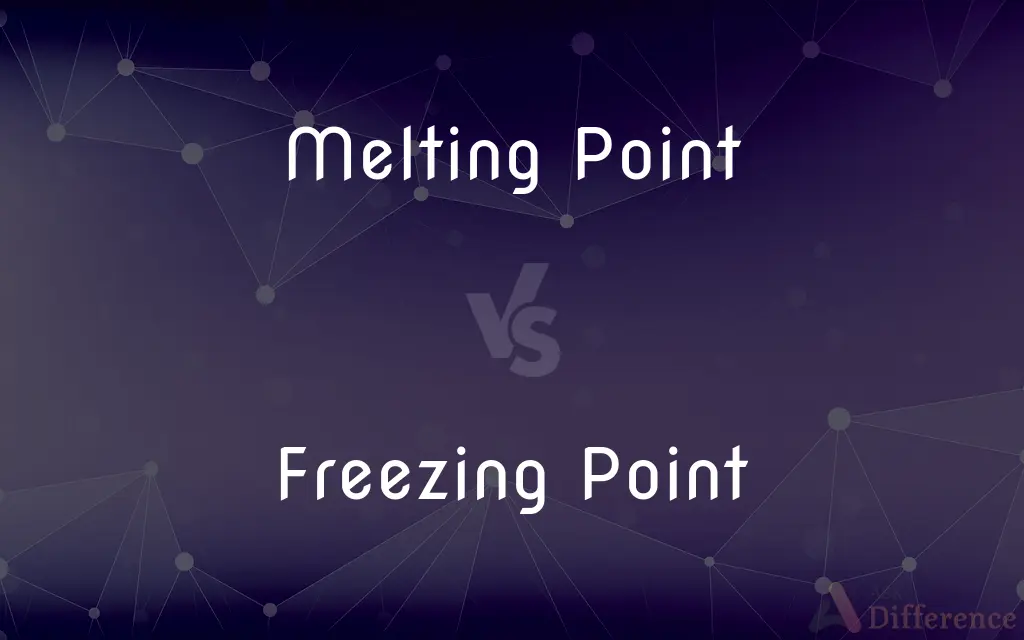Melting Point vs. Freezing Point — What's the Difference?
By Tayyaba Rehman & Fiza Rafique — Published on March 3, 2024
Melting point is the temperature at which a solid becomes a liquid, whereas freezing point is the temperature at which a liquid becomes a solid, illustrating the phase change in opposite directions.

Difference Between Melting Point and Freezing Point
Table of Contents
ADVERTISEMENT
Key Differences
Melting point and freezing point refer to temperatures at which substances change states between solid and liquid, but they represent these changes in opposite directions. While the melting point is the temperature at which a solid becomes a liquid, indicating the end of solidity, the freezing point marks the temperature at which a liquid solidifies, signifying the loss of fluidity. This distinction is fundamental in understanding the behavior of substances in response to temperature changes.
Both points are crucial for characterizing substances, especially in chemistry and physics. The melting point is particularly important for identifying substances, as pure substances have specific melting points. In contrast, the freezing point is key in meteorology and food preservation, where the transition of water to ice and vice versa has practical implications.
Interestingly, for many pure substances, the melting point and freezing point are the same temperature. This phenomenon occurs under stable conditions, where the transition from solid to liquid (melting) or liquid to solid (freezing) happens at a constant temperature. However, the presence of impurities can cause these points to differ due to melting point depression or freezing point depression.
In practice, the determination of melting and freezing points is used to assess purity and to understand the thermal properties of materials. The melting point helps in determining the purity of a substance, as impurities usually lower the melting point. Conversely, the freezing point can indicate the presence of solutes in a liquid, as solutes typically lower the freezing point of a solution compared to the pure solvent.
Environmental conditions, especially pressure, also play a significant role in these temperatures. The melting point of ice, for example, decreases under pressure, which is why ice skates can glide over ice. The freezing point, similarly, can be affected by pressure, but is more commonly influenced by the presence of solutes, which is why salt is used to melt ice on roads.
ADVERTISEMENT
Comparison Chart
Definition
Temperature at which a solid becomes a liquid
Temperature at which a liquid becomes a solid
Phase Change Direction
Solid to Liquid
Liquid to Solid
Significance in Science
Identifies purity and specific characteristics
Important for understanding thermal properties
Common Applications
Material identification, quality control
Food preservation, meteorology
Dependency
Can be altered by impurities and pressure
Influenced by solutes and environmental conditions
Compare with Definitions
Melting Point
Can be altered by the presence of impurities.
Salt lowers the melting point of ice.
Freezing Point
A key factor in weather prediction.
Forecasting snow requires knowing the freezing point of water.
Melting Point
The temperature at which a solid turns into a liquid.
The melting point of ice is 0°C.
Freezing Point
Influenced by solutes in the liquid.
Saltwater freezes at a lower temperature than pure water.
Melting Point
Used to determine the purity of a substance.
A higher melting point indicates a pure substance.
Freezing Point
The temperature at which a liquid turns into a solid.
The freezing point of water is 0°C.
Melting Point
A characteristic physical property of a substance.
Diamond has a melting point of over 3500°C.
Freezing Point
Essential for food storage techniques.
Freezing point depression is used to make creamy ice cream.
Melting Point
Influenced by atmospheric pressure.
The melting point of wax decreases slightly under high pressure.
Freezing Point
Can be indicative of solution concentration.
The freezing point decreases as salt concentration increases.
Common Curiosities
What does a lower freezing point indicate?
It often indicates the presence of solutes in a liquid.
Can the freezing point change?
Yes, it can change with the addition of solutes or changes in pressure.
What applications rely on freezing point knowledge?
Meteorology, food preservation, and road safety during winter.
Why does salt lower the freezing point of water?
Salt disrupts the formation of ice crystals, lowering the temperature at which water can freeze.
How does pressure affect the melting point?
Increasing pressure typically lowers the melting point of solids.
How can melting point and freezing point be measured?
Through thermal analysis techniques, such as differential scanning calorimetry.
Why is the melting point important?
It helps in identifying substances and assessing their purity.
What is the significance of freezing point in meteorology?
It helps in predicting freezing conditions and ice formation.
How is the melting point used in quality control?
It verifies the purity of substances in pharmaceuticals and chemicals.
Are melting point and freezing point always the same?
For pure substances under stable conditions, yes, but impurities can cause differences.
Is the melting point affected by impurities?
Yes, impurities usually lower the melting point.
What role does the freezing point play in food preservation?
It helps in determining the storage conditions to prevent spoilage.
Can melting point determine the composition of a mixture?
It can provide clues, but additional analysis is often required for precise composition determination.
Does the freezing point of water always remain constant?
No, it can vary with changes in pressure and the presence of impurities.
What is melting point depression?
A decrease in the melting point caused by impurities in a substance.
Share Your Discovery

Previous Comparison
Binding vs. Non Binding
Next Comparison
Old World Monkeys vs. New World MonkeysAuthor Spotlight
Written by
Tayyaba RehmanTayyaba Rehman is a distinguished writer, currently serving as a primary contributor to askdifference.com. As a researcher in semantics and etymology, Tayyaba's passion for the complexity of languages and their distinctions has found a perfect home on the platform. Tayyaba delves into the intricacies of language, distinguishing between commonly confused words and phrases, thereby providing clarity for readers worldwide.
Co-written by
Fiza RafiqueFiza Rafique is a skilled content writer at AskDifference.com, where she meticulously refines and enhances written pieces. Drawing from her vast editorial expertise, Fiza ensures clarity, accuracy, and precision in every article. Passionate about language, she continually seeks to elevate the quality of content for readers worldwide.
















































